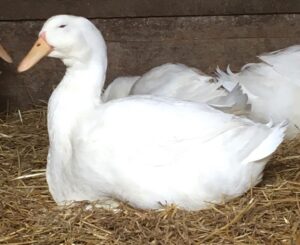Ducks and Geese: Looking Back at 45 Years
This article on looking back at the past 45 years of exhibition poultry, specifically ducks and geese, is being republished from Acorn Hollow Bantams website with permission from Lou Horton.
When I began showing waterfowl in the last half of the 1960s, the big birds were where it was at both in terms of quantity and certainly, quality. I recall classes of Rouens at the Wisconsin State Fair that exceeded 40 birds and which featured not one or two but as many as 6-7 noted breeders of Rouens. The same was true for many breeds of the large ducks and classes of many of the breeds of geese were large and competitive. The difference between then and now is that most breeds were supported by multiple breeders. That meant that the gene pool was generally in good shape and that the breed was progressing well due to the efforts of several devoted people. Today, a given breed may offer the illusion of good support if one stops at counting the number of exhibitors at a show. What further investigation may reveal, however, is that a significant number of the exhibitors are not breeding the birds that they show and in fact may all be getting their show birds from the same one or two people. If those people (for any reason) stop turning out numbers of good birds for even a few years, the number of exhibited birds in that breed may crash. I am sure that the same may be true in many breeds of large fowl and perhaps in some breeds of bantams.
Classes of the small ducks were not especially large and, at least compared to today, the quality was poor. Many birds were shown in poor condition and in the Calls, sinus infections were quite common. Of course, the showing of birds with obvious health and/or condition problems was not limited to the Calls. I recall seeing and even judging Toulouse at major shows with slipped and even angel wing(s). Of course, those defects were considered just as serious back then as they are today but sometimes a judge would place a good specimen with such a problem rather than going with a grossly inferior bird. The main problem with the Toulouse back then was what I referred to earlier; key breeders had died or had given up raising the breed. It wasn’t until David Reath began to raise numbers of Toulouse through the use of artificial insemination that the quality birds began to be seen again. David also worked wonders with ducks, such as Aylesburys, and geese, such as quality of African geese, during the 1970s and 1980s.

The Black East Indies were in an interesting situation during the early 1970s through the late 1980s. The best birds were well colored and displayed pretty good Indie type but they were huge by today’s standards. Many Indies at shows approached three lbs. in weight. Breeders like John Kriner put a high premium on color and were willing to sacrifice size to achieve that. Some Indie breeders like Stanley Osika of Indiana were experimenting with crosses with Calls to bring down the size but were giving up some Indie type in the process. Still others believed that if one began with breeders that were of good basic type and which possessed good color the problem of oversize would take care of itself if one raised good numbers over a period of years. By the late 1980s, the Indies were good enough to challenge the Calls for champion bantam duck but it took a couple of well-respected judges who were not afraid to buck current trends to get other judges to begin to take a second look at the Indies. I will always be grateful to Lewis Cunningham and Wilbur Stauffer for their willingness to trust their judgment rather than just following the crowd.
The truth is that during the 1960s and 1970s, judges who were truly familiar with waterfowl were few and far between. Some judges who were or had been “string men” had a distinct advantage because their “strings” often included waterfowl and of course, there were judges like Choice Culver, Henry Miller, and Al Barry, among others who were waterfowl men. All three also knew and judged chickens as well as turkeys.
In spite of the fact that at many shows, waterfowl were a significant number of the total entry, they were often relegated to the poorest location in the showroom and frequently were given the oldest, poorest caging. That situation was a major reason that the IWBA was formed in the early 1970s. The International Waterfowl Breeders Association pushed for better showing conditions, provided a list of established waterfowl judges upon request, and held meets all over the U.S. and Canada. Gradually, conditions improved at many shows. For those shows not interested in changing, waterfowl exhibitors often took their birds and their entry money elsewhere.
The next time, I will discuss how other individual breeds have changed over the past decades.
Click here to read part one of this series.
Ducks and Geese: Looking back at 45 years by Lou Horton
